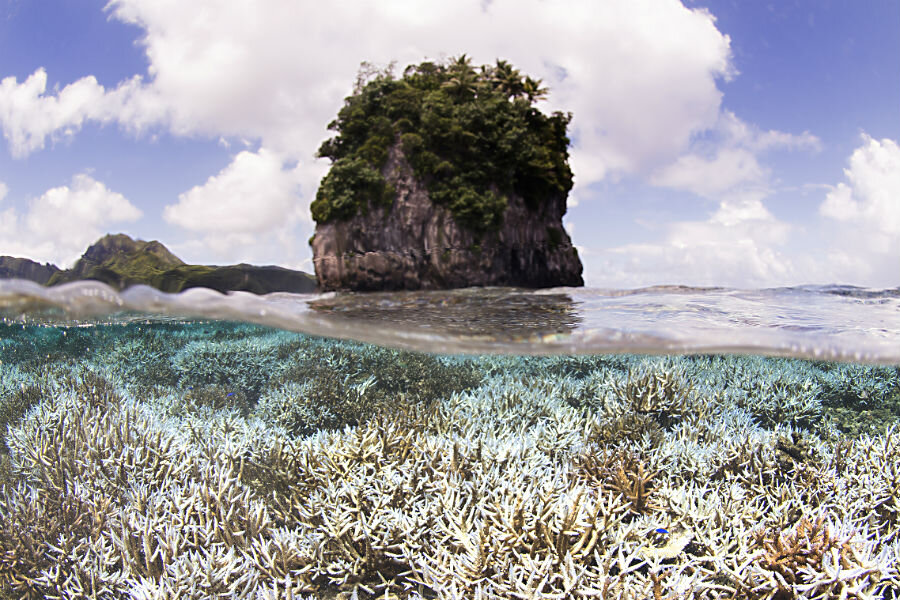Widespread bleaching threatens Great Barrier Reef: why that matters
Loading...
An Australian research team’s analysis of the Coral Sea region of the southern Pacific Ocean highlights the significant threat facing coral reefs there due to high levels of coral bleaching, and what effect the loss of the reefs could have on ocean life and human enterprise.
After aerially documenting widespread coral bleaching off Australia’s coast, the Commonwealth's National Coral Bleaching Taskforce reported this week that the country’s coral is at an all-time high risk from the harmful process.
“This has been the saddest research trip of my life,” said Terry Hughes, who gathered the task force together. “Almost without exception, every reef we flew across showed consistently high levels of bleaching, from the reef slope right up onto the top of the reef.”
If the reefs continue to be impacted by bleaching, the effects could be severe around Australia’s Coral Sea and beyond. Around 15 percent of the world’s population lives within 70 miles of a reef ecosystem, Commonwealth Scientific and Industrial Research Organisation (CSIRO.) The agency also found that nearly $100 billion in tourism was generated annually from only the Great Barrier Reef, Floridean reefs, and Caribbean reefs in the 1990s, meaning a significant economic slump could hit those areas if bleaching ends up spreading and hurting more reef systems. The CSIRO report said that costs associated with “totally losing coral reefs would run into hundreds of billions of dollars each year.”
While reef decline would affect larger economies as a whole, poorer regions would suffer from widespread bleaching as well. A World Resources Institute report issued in 1998 stated that “coral reefs contribute about one-quarter of the total fish catch” in developing countries, meaning that those nations’ food supply and trade products could be cut down as well.
CSIRO also estimated that by 2040, most coral reefs would experience “near-annual bleaching events,” a prediction that may prove to be ahead of schedule. And with greenhouse gas emissions and climate change suspected as the main culprits in the rise of bleaching, scientists say human activity needs to change in order to save the coral.
Coral bleaching, the loss of endosymbiotic organisms that live within coral tissue, was not observed until late in the 20th century, leading many to infer that the process results from human causes. An Australian Institute of Marine Science researcher told Australia’s ABC News that signatures of bleaching were not observed until after severe events in the late 1990s and early 2000s. And the effect of rising temperatures on oceans related to human activity impacts the coral as well.
“What we're seeing now is unequivocally to do with climate change,” University of Queensland reef scientist Justin Marshall told ABC’s 7.30. “The world has agreed, this is climate change, we're seeing climate change play out across our reefs.”
Coral bleaching is a phenomenon that causes coral to lose essential protozoan zooxanthellae that inhabit the reefs. The photosynthetic zooxanthellae, similar to algae, live within the tissues of coral and give the reefs their vibrant coloring.
Zooxanthellae are expelled through the bleaching process, which can result from environmental stresses such as rising temperatures and the introduction of sediments or chemicals, according to CSIRO. With the loss of zooxanthellae, coral quickly loses its color and appears bleach-white, stops growing, and may potentially die.
“Scientists in the water are already reporting up to 50% mortality of bleached corals,” Mr. Hughes said of Australia's reefs, adding that “it’s still too early to tell just what the overall outcome will be.”
While reefs farther south benefit from cooler waters near Antarctica, if ocean temperatures continue to rise they may be impacted just as badly as the reefs farther north closer to the Equator already are. And with no practical recourse to counteract widespread bleaching events, scientists hope that either the reefs will adapt, or people will.
“We've been complacent on this issue for far too long. We can have our corals, or we can have our complacency,” World Wildlife Federation spokesman Nick Heath said to The Sydney Morning Herald. “If we don't start to see some real leadership on the Reef, it will be gone.”
Hughes’ task force found that, of more than 500 reefs analyzed in the hundreds of miles of ocean between Cairns, Australia, and Papua New Guinea, only four exhibited no signs of bleaching.








